#Co.Design
Explore tagged Tumblr posts
Photo

Cars and trucks are getting bigger, and it’s causing a safety crisis on our streets Deadly pedestrian traffic incidents have declined in most developed countries—but in the U.S., they’ve risen by 77% since 2010. Deadly traffic incidents have declined in most developed countries in recent years. But in the U.S., they’re becoming more common. Deaths in motor vehicle crashes rose more than 33% from 2011 to 2021. Since 2010, pedestrian deaths nationwide have climbed a shocking 77%, compared with a 25% increase in all other types of traffic fatalities.Read Full Story https://www.fastcompany.com/90932290/cars-and-trucks-are-getting-bigger-and-its-causing-a-safety-crisis-on-our-streets?partner=rss&utm_source=rss&utm_medium=feed&utm_campaign=rss+fastcompany&utm_content=rss
0 notes
Text

#UglyHousesILike #InfectedRealtorAU #MyThoughts
I imagine the REALTOR of this house being very snooty but the house body has too much going on.


This house maybe weird but I like it.
This looks like it was originally a apartment building turned into a house but that's my guess.
This is a pretty creative house but I wish I could see the inside of it.
Images not mine but link is there.
Images not mine but links are there.
Co.Design on X: "Is this the ugliest house in America? http://t.co/Exdb1hmNuU http://t.co/LZ5cvYa86a" / X (twitter.com)
Incredibly skinny and weird house for sale in Revere - Buying - Boston.com Real Estate
0 notes
Link
Studies have found that we enjoy things more when they're surprise discoveries rather than things we deliberately choose. Companies are putting this knowledge to use in clever ways.
#Co.Design#evidence#news#currentindia#current india#india news#latest news#world news online#news from world#india latest news#live news india#current india news#latest india breaking news
0 notes
Photo
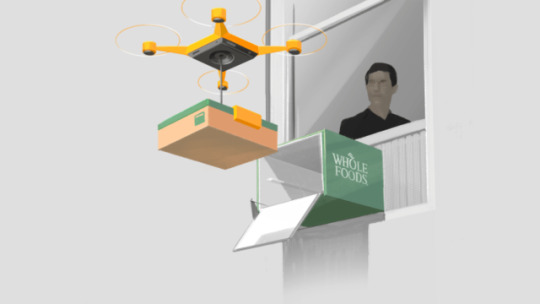
A Wild Vision Of The Future Run By Amazon And Whole Foods
CONTENT SOURCED FROM CO.DESIGN
Drones. Shared refrigerators. Hydroponic garages. And never setting foot in a grocery store again.
Since Amazon bought Whole Foods for $13.7 billion, consumers have been left wondering what that partnership will ultimately look like. Will Whole Foods stores just become another face for Amazon’s anonymous distribution centers? Will Prime memberships include access to more local produce? Or will retail, as we know it, fundamentally change, as Amazon’s hyper efficiency mixes with the Whole Foods fresh, local mentality to create something entirely new?
Austin-based design firm Argodesign is betting on the latter. As a thought experiment, the studio mocked up a provocative series of concepts suggesting what an Amazon Foods could look like, if powered by drones, Echo refrigerators, and a sharing economy model reminiscent of Airbnb or Uber.
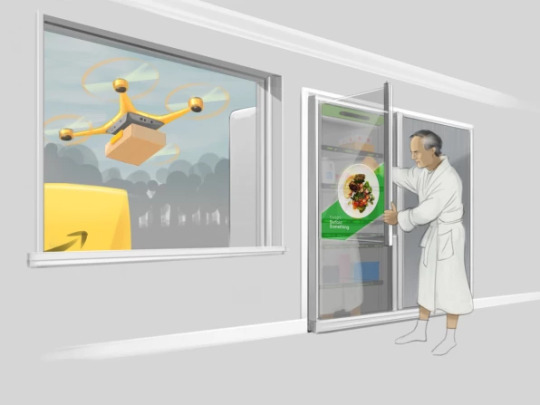
[Illustration: courtesy Argodesign]
MEET THE ECHO FRIDGE
Right now, you might order groceries through your Echo personal assistant, or reorder something through an Amazon Dash button. These items might arrive in a few hours or a few days. But what if Amazon/Whole Foods could move its stock from distribution centers and store shelves to your shelves, predictively, and adaptively?
That’s the idea of the Echo Fridge. It has an exterior-facing door. In suburban houses, it’s large, allowing a small vehicle to pull up. In urban areas, it’s a box about the size of an AC unit. Through this door, the fridge would take deliveries of food Amazon believes you will want. But you don’t pay for them unless you use them.
On the kitchen side of the Echo Fridge, you might see two doors. The door on the right would have Amazon’s suggested items, ready to eat. Move them to the left door–your personal space–and they’d be purchased automatically. Leave them, and they might be removed, delivered to a neighbor who wants that bag of oranges or bottle of ketchup.
“When we started looking at the whole problem, we started from the high level: improving distribution through robotics, and this centerpiece idea of making the refrigerator the point of sale,” says Mark Rolston, founder of Argodesign. “If you start with that point of logic, because of improved distribution, availability of robotics, and support of drones, you start to realize, the inventory in the store starts to not really matter. And the store doesn’t matter as it does today to host inventory.”
This is the fundamental shift of the concept–the store is no longer the store. Your home is now the store. And while, yes, it’s a slightly unsettling thought to not own everything in your fridge, where Argodesign takes this idea empowers the individual–as much as it enslaves them to Amazon’s will.
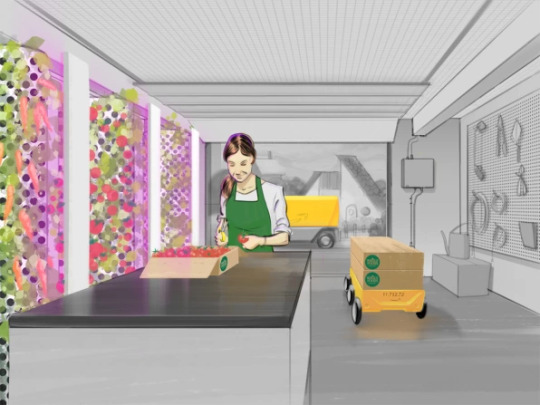
[Illustration: courtesy Argodesign]
THE GARAGE GARDEN
If self-driving cars take over, fewer people will probably own cars, and there’s a good chance that the average suburban household will suddenly have an open room in their garage. Here, Argodesign imagines what they call “Whole Foods Produce As Service.” For a monthly fee, you get a hydroponic system, with hardware owned and maintained by Amazon, and an employee comes by every few weeks to prune your garden.
You take what you like–and possibly pay a subsidized price for the fresh tomatoes and herbs. The rest is sold in a hyperlocal farmers’ market. Much like your fridge shares unopened milk, your garden would share ripe veggies that would otherwise go uneaten.
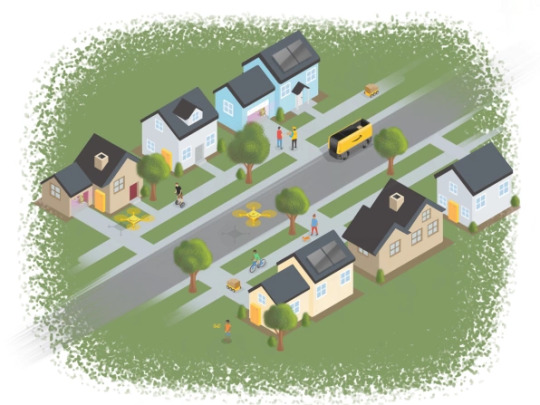
[Illustration: courtesy Argodesign]
“Everyone thinks Amazon is the big dog, and it will just gut the [Whole Food] stores,” says Jared Ficklin, creative technologist and partner at the firm. “I doubt that. I think Whole Foods will have an influence as well.” In a best-case scenario, that influence would tap Whole Foods’ ability to source regional produce, but at the extreme scale. Local fresh would no longer constitute a farm 100 miles away. Local fresh would be turnips grown by someone in your cul-de-sac.
“If Amazon is doing this successfully, it’s kind of scary. I could imagine a reader saying, ‘Holy shit, you want Amazon to be wholly in charge of what you eat?” says Rolston.
“No, we want Whole Foods to be in charge of what you eat!” says Ficklin.
“We want to plug into this system,” says Rolston. “It’s [Amazon’s] infrastructure. But it’s for us, feeding ourselves. Their infrastructure allows us to share our food in a more productive way.”

[Illustration: courtesy Argodesign]
UNLOC FOOD SCANNER
In what is by far the most science fiction-y idea in this bunch, Argodesign takes food sharing to its ultimate conclusion. With the Unloc Food Scanner, not only could you grow produce for your neighbors, you could cook meals for them, too.
Amazon would be something like Blue Apron crossed with Airbnb–for dinner, “right down to finding the person in your neighborhood [who] makes amazing Indian food to get them 20 customers,” says Ficklin.
The scanner would be loaded with a mass spectrometer, capable of looking at a dish to spot allergens and pathogens. Each package would be like a mini FDA, that could ensure a home-cooked dish from four doors down was safe for you to eat.
“We thought of this Tupperware container that scans the food and nutritional value, and it occurred to us, if you had something like that, you could usurp the packaged food industry,” says Ficklin. “A lot of work goes into food safety rather than nutrition. If you ever tried to sell something at a farmers’ market, you realize you’re up against big government. With a container like this, you could decide to sell your amazing Waldorf salad to neighbors, and they could know that there are no peanuts in it.”
It’s a wild idea, yes, but it’s also an excellent example of how a company with limitless resources, and motivation to ship things as little as possible to save money and expedite delivery times, could actually empower hyperlocal eating. (It could be a fun way to meet your neighbors, too.)
“What do people do in their lives when automation takes away so much of the manual craft we spend our time doing?” Rolston ponders aloud. “It could turn life into the Etsy of everything, the bespoking of the most ordinary aspects of living. Maybe, rather than keeping us away from each other, stronger data systems help us get closer to each other.”

[Illustration: courtesy Argodesign]
THE AMAZON BIN
For the final item in the concept brief, Amazon would leverage its network not to deliver your food but to take your trash.
Maybe you’ve tried something Amazon has sent you, and you didn’t like it at all. But all Amazon sees is that you consumed it. How does Amazon learn what you like, and what you don’t–as passively as possible?
For this, Argodesign suggests the Amazon Bin. It’s a garbage can with two holes. One says reorder. One says don’t. Anything going in is scanned, and so Amazon learns your preferences by your garbage.
But the much bigger play is what Argodesign has dubbed “waste as service.” They postulate that Amazon can create a revenue stream out of recyclables, while rewarding users for better habits. An apple thrown out whole might, at the end of the month, cost the user more than one that is eaten. But that same user might get a credit for recycling a can of consumed Diet Coke. At scale, it would be a mindless way for consumers to be greener, allowing Amazon to recycle and compost their goods. And it might lead to some earned back cash, too.
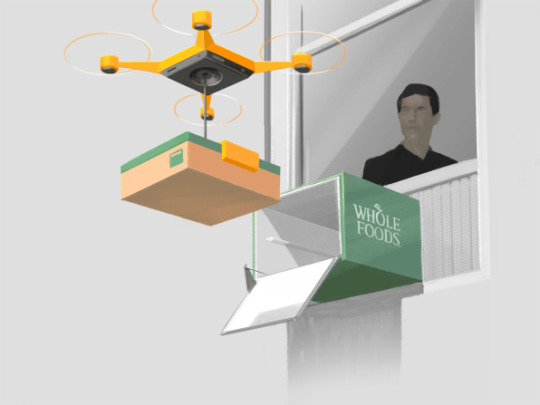
[Illustration: courtesy Argodesign]
A DISQUIETING FUTURE? MAYBE
As irresistible as it may be to open your fridge and see a gleaming produce aisle that’s been automatically, algorithmically delivered staring back at you, of course it’s all equally unsettling, too. Do I really want to buy milk that was stored in my neighbor’s fridge? Wouldn’t I be crazy to let Amazon catalog how much of that Snickers bar I actually ate? Who in their right mind would allow a big corporation to install their own garden in their precious garage?
“Isn’t Etsy proof enough?” Rolston asks. “For Airbnb, Uber, Etsy, the initial reaction was always more abstracted, divorced from the moment of value. ‘I’m not getting in some stranger’s car! I’m not buying random shit from a neighbor down the street! I’m not staying in a stranger’s house! And then, ‘okay!’–it becomes a thing.”
Ficklin chimes in. “I think the argument you’re making is very similar to the privacy argument, where people are creeped out to give privacy to get features,” he says. “But you know what consumers do every time? They give up privacy to get features! People still say, ‘This is gross and creepy!’ but they immediately do it because it’s easier and better.”
CONTENT SOURCED FROM CO.DESIGN
#amazon#wholefoods#drones#hydroponics#hydroponic farming#vertical farming#urban agriculture#urban farming#sharing economy#local food#hyperlocal#farmersmarket#futurism#tech#retail#Argodesign#Amazonbin#Co.Design
14 notes
·
View notes
Quote
Fast Companyが運営するCo.Designは「黄金比は都市伝説である」と論じる記事を掲載しています。
「黄金比」はデザイン史における最大の都市伝説なのか? - GIGAZINE
2015年04月14日
The Golden Ratio: Design's Biggest Myth | Co.Design | business + design
4 notes
·
View notes
Photo

ノルウェーの企業Wind Catching Systemsが開発している通常の5倍のエネルギーを生成できる風力タービン (Co.Design) This wildly reinvented wind turbine generates five times more energy than its competitors (Co.Design)
8 notes
·
View notes
Photo

How I Taught Steve Jobs To Put Design First | Co.Design | business + design https://ift.tt/3aWyGfh
2 notes
·
View notes
Text
Philographics: Big Ideas in Simple Shapes

Philographics: Big Ideas in Simple Shapes by Genis Carreras
"It takes the Stanford Encyclopedia of Philosophy 28,250 words to explain the woolly concept of relativism. It takes Genis Carreras 32 words and a single image. If you ask me, he doesn't even need the text."—Co.Design "Remarkable visual eloquence in his Philographics project."—Brain Pickings Philographics is all about explaining big ideas in simple shapes, merging the world of philosophy and graphic design. Here are ninety-five designs, each depicting a different "–ism" using a unique combination of geometric shapes, colors, and a short definition of the theory.
Download : Philographics: Big Ideas in Simple Shapes More Book at: Zaqist Book
1 note
·
View note
Link
Half of Uruguay’s COVID-19 cases can be traced to a single fashion designer
0 notes